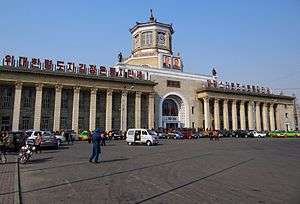Pyongyang Station
P'yŏngyang 평양 | ||||||||||||||||||||||||||||||
|---|---|---|---|---|---|---|---|---|---|---|---|---|---|---|---|---|---|---|---|---|---|---|---|---|---|---|---|---|---|---|
 Street facade of the railway station | ||||||||||||||||||||||||||||||
| Korean name | ||||||||||||||||||||||||||||||
| Hangul | 평양역 | |||||||||||||||||||||||||||||
| Hanja | 平壌驛 | |||||||||||||||||||||||||||||
| Revised Romanization | Pyeongyang-yeok | |||||||||||||||||||||||||||||
| McCune–Reischauer | P'yǒngyang-yǒk | |||||||||||||||||||||||||||||
| General information | ||||||||||||||||||||||||||||||
| Location |
P'yǒngyang North Korea | |||||||||||||||||||||||||||||
| Owned by | Korean State Railway | |||||||||||||||||||||||||||||
| Platforms | 3 (2 island platforms) | |||||||||||||||||||||||||||||
| Tracks | 6 | |||||||||||||||||||||||||||||
| Connections |
Tram Line 1 Metro: Ch'ǒllima Line | |||||||||||||||||||||||||||||
| History | ||||||||||||||||||||||||||||||
| Opened | 1906 | |||||||||||||||||||||||||||||
| Rebuilt | 1958 | |||||||||||||||||||||||||||||
| Electrified | yes | |||||||||||||||||||||||||||||
| Services | ||||||||||||||||||||||||||||||
| ||||||||||||||||||||||||||||||
Pyongyang Station (Korean: 평양역) is the central railway station of Pyongyang, North Korea.[1]
Main information
The station is the start of the P'yŏngbu and P'yŏngŭi lines, which were adjusted from the Kyŏngbu and Kyŏngŭi lines used before the division of Korea to accommodate the shift of the capital from Seoul to P'yŏngyang. The P'yŏngŭi Line runs from P'yŏngyang to Sinŭiju, while the P'yǒngbu Line theoretically runs through Seoul and ends at Busan; in practice, however, the line ends at Kaesǒng. It is also served by the P'yǒngnam Line, which runs from P'yŏngyang to Namp'o, as well as the P'yŏngdŏk Line running from P'yŏngyang to Kujang.
Connections

P'yŏngyang Station is the main station in North Korea and it connects most of the cities of the country: Chŏngju, Sinŭiju, Namp'o, Sariwŏn, Kaesŏng, Wŏnsan, Hamhŭng and Rason. Beside domestic routes, international destinations such as Beijing and Moscow are available by night trains, and there are daily passenger trains to the Chinese border city of Dandong. There are presently no scheduled trains to Seoul (about 250 km (155 mi) away), due to the separation of the two Koreas.
Local transit connections can be made at the station via Pyongyang Metro's Ryǒngwang Station (on the Ch'ŏllima Line), and by Line 1 of the P'yŏngyang tram system.
Structure
The original station was constructed in the 1920s. During the Korean War, the original structure was destroyed and later on rebuilt in 1958[2] in the style of socialist architecture. The station presently has three floors above ground level as well as a basement.[3] The ground level houses a ticket desk exclusively for government employees. At the first floor there is a waiting room, toilets, a ticket desk and access to the trains. At the second floor there are offices for the staff and at the third the office of the station master. There are five platforms, with number 1 being the most spacious.
References
External links
- Introduction of Pyongyang Station (Japanese)
Coordinates: 39°00′17″N 125°44′11″E / 39.00472°N 125.73639°E